Unlocking Drone Potential in the Pharma Supply Chain: A Hybrid Machine Learning and GIS Approach
Abstract
:1. Introduction
2. Literature Review
2.1. Advanced Air Mobility
2.2. Medical Drone Deliveries
3. Methodology
3.1. Data Mining Workflow
- Freight Analysis Framework (FAF) maintained by the Bureau of Transportation Statistics (BTS) of the U.S. Department of Transportation (USDOT) and the U.S. Census Bureau (USCB) [48]. Version 5 of the FAF dataset contained 2.2 million records. Each record contained the following information about freight moved: origin, destination, commodity type, transport mode, tonnage, and value.
- Shapefiles of U.S. counties from the TIGER™ dataset [49] maintained by the USCB. The 2021 version of the dataset defined the boundaries of all 3142 counties of the United States.
- A commodity flow survey geographies database [50]. The 2017 version of the dataset defined the U.S. counties that make up 130 commodity flow survey areas.
- (1)
- A table of origins by commodity type.
- (2)
- A table of destinations by commodity type.
3.2. Unsupervised Machine Learning
3.3. Distance Band Distribution
4. Results and Discussion
4.1. Outlier MSAs
4.2. Distance Band Distribution
4.3. Limitations
5. Conclusions
Funding
Institutional Review Board Statement
Informed Consent Statement
Data Availability Statement
Conflicts of Interest
References
- ACI. Air Cargo Guide; Airports Council International (ACI) North America: Montreal, QC, Canada, 2019. [Google Scholar]
- Perera, S.; Dawande, M.; Janakiraman, G.; Mookerjee, V. Retail Deliveries by Drones: How Will Logistics Networks Change? Prod. Oper. Manag. 2020, 29, 2019–2034. [Google Scholar] [CrossRef]
- GAO. Transforming Aviation: Stakeholders Identified Issues to Address for ‘Advanced Air Mobility’; Government Accountability Office (GAO): Washington, DC, USA, 2022. [Google Scholar]
- Lineberger, R.; Silver, D.; Hussain, A. Advanced Air Mobility: Can the United States Afford to Lose the Race; Deloitte Development LLC: London, UK, 2021. [Google Scholar]
- Sahoo, S.; Zhao, X.; Kyprianidis, K. A Review of Concepts, Benefits, and Challenges for Future Electrical Propulsion-Based Aircraft. Aerospace 2020, 7, 44. [Google Scholar] [CrossRef] [Green Version]
- Garg, S.; Aujla, G.S.; Erbad, A.; Rodrigues, J.J.P.C.; Chen, M.; Wang, X. Guest Editorial: Blockchain Envisioned Drones: Realizing 5G-Enabled Flying Automation. IEEE Netw. 2021, 35, 16–19. [Google Scholar] [CrossRef]
- Sharifi, F.; Meitiv, A.; Shelton, J.; Xu, X.; Burris, M.; Vallamsundar, S.; Xu, Y.A. Regional traffic operation and vehicle emission impact assessment of lane management policies. Res. Transp. Econ. 2021, 91, 101067. [Google Scholar] [CrossRef]
- Nisingizwe, M.P.; Ndishimye, P.; Swaibu, K.; Nshimiyimana, L.; Karame, P.; Dushimiyimana, V.; Musabyimana, J.P.; Musanabaganwa, C.; Nsanzimana, S.; Law, M.R. Effect of unmanned aerial vehicle (drone) delivery on blood product delivery time and wastage in Rwanda: A retrospective, cross-sectional study and time series analysis. Lancet Glob. Health 2022, 10, e564–e569. [Google Scholar] [CrossRef]
- Rejeb, A.; Rejeb, K.; Simske, S.J.; Treiblmaier, H. Drones for supply chain management and logistics: A review and research agenda. Int. J. Logist. Res. Appl. 2021, 26, 708–731. [Google Scholar] [CrossRef]
- Ayamga, M.; Akaba, S.; Nyaaba, A.A. Multifaceted applicability of drones: A review. Technol. Forecast. Soc. Chang. 2021, 167, 120677. [Google Scholar] [CrossRef]
- FAA. Urban Air Mobility: Concept of Operations, v1.0; Federal Aviation Administration (FAA): Washington, DC, USA, 2020. [Google Scholar]
- Uber Elevate. Fast-Forwarding to a Future of On-Demand Urban Air Transportation; Uber: Santa Cruz, CA, USA, 2016. [Google Scholar]
- Bridgelall, R.; Askarzadeh, T.; Tolliver, D.D. Introducing an efficiency index to evaluate eVTOL designs. Technol. Forecast. Soc. Chang. 2023, 191, 122539. [Google Scholar] [CrossRef]
- Jung, H.; Kim, J. Drone scheduling model for delivering small parcels to remote islands considering wind direction and speed. Comput. Ind. Eng. 2021, 163, 107784. [Google Scholar] [CrossRef]
- Ma, Y.; Zhang, W.; Zhang, Y.; Zhang, X.; Zhong, Y. Sizing Method and Sensitivity Analysis for Distributed Electric Propulsion Aircraft. J. Aircr. 2020, 57, 730–741. [Google Scholar] [CrossRef]
- Chung, S.H.; Sah, B.; Lee, J. Optimization for drone and drone-truck combined operations: A review of the state of the art and future directions. Comput. Oper. Res. 2020, 123, 105004. [Google Scholar] [CrossRef]
- Dong, C.; Akram, A.; Andersson, D.; Arnäs, P.-O.; Stefansson, G. The impact of emerging and disruptive technologies on freight transportation in the digital era: Current state and future trends. Int. J. Logist. Manag. 2021, 32, 386–412. [Google Scholar] [CrossRef]
- Banik, D.; Hossain, N.U.I.; Govindan, K.; Nur, F.; Babski-Reeves, K. A decision support model for selecting unmanned aerial vehicle for medical supplies: Context of COVID-19 pandemic. Int. J. Logist. Manag. 2022, 34, 473–496. [Google Scholar] [CrossRef]
- Thiels, C.A.; Aho, J.M.; Zietlow, S.P.; Jenkins, D.H. Use of Unmanned Aerial Vehicles for Medical Product Transport. Air Med. J. 2015, 34, 104–108. [Google Scholar] [CrossRef] [PubMed]
- Johnson, A.M.; Cunningham, C.J.; Arnold, E.; Rosamond, W.D.; Zègre-Hemsey, J.K. Impact of Using Drones in Emergency Medicine: What Does the Future Hold? Open Access Emerg. Med. 2021, 13, 487–498. [Google Scholar] [CrossRef]
- Laksham, K. Unmanned aerial vehicle (drones) in public health: A SWOT analysis. J. Fam. Med. Prim. Care 2019, 8, 342–346. [Google Scholar] [CrossRef] [PubMed]
- Beck, S.; Bui, T.T.; Davies, A.; Courtney, P.; Brown, A.; Geudens, J.; Royall, P.G. An evaluation of the drone delivery of adrenaline auto-injectors for anaphylaxis: Pharmacists’ perceptions, acceptance, and concerns. Drones 2020, 4, 66. [Google Scholar] [CrossRef]
- Scalea, J.R.; Pucciarella, T.; Talaie, T.; Restaino, S.; Drachenberg, C.B.; Alexander, C.; Al Qaoud, T.; Barth, R.N.; Wereley, N.M.; Scassero, M. Successful Implementation of Unmanned Aircraft Use for Delivery of a Human Organ for Transplantation. Ann. Surg. 2019, 274, e282–e288. [Google Scholar] [CrossRef]
- Shirane, T. A Systematic Review of Effectiveness of Automated External Defibrillators Delivered by Drones. Glob. J. Health Sci. 2020, 12, p101. [Google Scholar] [CrossRef]
- Mermiri, M.I.; Mavrovounis, G.A.; Pantazopoulos, I.N. Drones for Automated External Defibrillator Delivery: Where Do We Stand? J. Emerg. Med. 2020, 59, 660–667. [Google Scholar] [CrossRef] [PubMed]
- Baumgarten, M.C.; Röper, J.; Hahnenkamp, K.; Thies, K.-C. Drones delivering automated external defibrillators—Integrating unmanned aerial systems into the chain of survival: A simulation study in rural Germany. Resuscitation 2021, 172, 139–145. [Google Scholar] [CrossRef]
- Cheskes, S.; McLeod, S.L.; Nolan, M.; Snobelen, P.; Vaillancourt, C.; Brooks, S.C.; Dainty, K.N.; Chan, T.C.Y.; Drennan, I.R. Improving Access to Automated External Defibrillators in Rural and Remote Settings: A Drone Delivery Feasibility Study. J. Am. Heart Assoc. 2020, 9, e016687. [Google Scholar] [CrossRef]
- Pulver, A.; Wei, R. Optimizing the spatial location of medical drones. Appl. Geogr. 2018, 90, 9–16. [Google Scholar] [CrossRef]
- Claesson, A.; Fredman, D.; Svensson, L.; Ringh, M.; Hollenberg, J.; Nordberg, P.; Rosenqvist, M.; Djarv, T.; Österberg, S.; Lennartsson, J.; et al. Unmanned aerial vehicles (drones) in out-of-hospital-cardiac-arrest. Scand. J. Trauma Resusc. Emerg. Med. 2016, 24, 1–9. [Google Scholar] [CrossRef] [Green Version]
- Sedig, K.; Seaton, M.; Drennan, I.; Cheskes, S.; Dainty, K. “Drones are a great idea! What is an AED?” novel insights from a qualitative study on public perception of using drones to deliver automatic external defibrillators. Resusc. Plus 2020, 4, 100033. [Google Scholar] [CrossRef]
- Truog, S.; Maxim, L.; Matemba, C.; Blauvelt, C.; Ngwira, H.; Makaya, A.; Moreira, S.; Lawrence, E.; Ailstock, G.; Weitz, A.; et al. Insights before Flights: How Community Perceptions Can Make or Break Medical Drone Deliveries. Drones 2020, 4, 51. [Google Scholar] [CrossRef]
- Hiebert, B.; Nouvet, E.; Jeyabalan, V.; Donelle, L. The Application of Drones in Healthcare and Health-Related Services in North America: A Scoping Review. Drones 2020, 4, 30. [Google Scholar] [CrossRef]
- O’keeffe, D.T.; Johnson, K.; Maraka, S. OR30-04 Autonomous Drone Delivery of Insulin. J. Endocr. Soc. 2020, 4 (Suppl. S1), OR30-04. [Google Scholar] [CrossRef]
- Hii, M.S.Y.; Courtney, P.; Royall, P.G. An Evaluation of the Delivery of Medicines Using Drones. Drones 2019, 3, 52. [Google Scholar] [CrossRef] [Green Version]
- Euchi, J. Do drones have a realistic place in a pandemic fight for delivering medical supplies in healthcare systems problems? Chin. J. Aeronaut. 2020, 34, 182–190. [Google Scholar] [CrossRef]
- Saeed, F.; Mehmood, A.; Majeed, M.F.; Maple, C.; Saeed, K.; Khattak, M.K.; Wang, H.; Epiphaniou, G. Smart delivery and retrieval of swab collection kit for COVID-19 test using autonomous Unmanned Aerial Vehicles. Phys. Commun. 2021, 48, 101373. [Google Scholar] [CrossRef]
- Pirabán, A.; Guerrero, W.J.; Labadie, N. Survey on blood supply chain management: Models and methods. Comput. Oper. Res. 2019, 112, 104756. [Google Scholar] [CrossRef]
- Zailani, M.A.H.; Sabudin, R.Z.A.R.; Rahman, R.A.; Saiboon, I.M.; Ismail, A.; Mahdy, Z.A. Drone for medical products transportation in maternal healthcare: A systematic review and framework for future research. Medicine 2020, 99, e21967. [Google Scholar] [CrossRef]
- Poljak, M.; Šterbenc, A. Use of drones in clinical microbiology and infectious diseases: Current status, challenges and barriers. Clin. Microbiol. Infect. 2020, 26, 409–410. [Google Scholar] [CrossRef]
- Dhote, J.; Limbourg, S. Designing unmanned aerial vehicle networks for biological material transportation—The case of Brussels. Comput. Ind. Eng. 2020, 148, 106652. [Google Scholar] [CrossRef]
- Ghelichi, Z.; Gentili, M.; Mirchandani, P.B. Logistics for a fleet of drones for medical item delivery: A case study for Louisville, KY. Comput. Oper. Res. 2021, 135, 105443. [Google Scholar] [CrossRef]
- Jackson, A.; Srinivas, S.A. Simulation-Based Evaluation of Drone Integrated Delivery Strategies for Improving Pharmaceutical Service. In Supply Chain Management in Manufacturing and Service Systems; International Series in Operations Research & Management Science; Srinivas, S., Rajendran, S., Ziegler, H., Eds.; Springer: Cham, Switzerland, 2021; Volume 304, pp. 185–204. [Google Scholar]
- Amicone, D.; Cannas, A.; Marci, A.; Tortora, G. A Smart Capsule Equipped with Artificial Intelligence for Autonomous Delivery of Medical Material through Drones. Appl. Sci. 2021, 11, 7976. [Google Scholar] [CrossRef]
- Li, J.; Goh, W.W.; Jhanjhi, N.Z. A design of IoT-based medicine case for the multi-user medication management using drone in elderly centre. J. Eng. Sci. Technol. 2021, 16, 1145–1166. [Google Scholar]
- Lin, C.A.; Shah, K.; Mauntel, L.C.C.; Shah, S.A. Drone delivery of medications: Review of the landscape and legal considerations. Am. J. Health Pharm. 2018, 75, 153–158. [Google Scholar] [CrossRef] [PubMed]
- Graf, L.; Anner, F. Autonomous Vehicles as the Ultimate Efficiency Driver in Logistics. In Disrupting Logistics: Startups, Technologies, and Investors Building Future Supply Chains; Springer: Cham, Switzerland, 2021; pp. 191–206. [Google Scholar] [CrossRef]
- Sanders, N.R.; Ganeshan, R. Big data in supply chain management. Prod. Oper. Manag. 2018, 27, 1745–1748. [Google Scholar] [CrossRef]
- FHWA. Freight Analysis Framework Verion 5 (FAF5). 22 November 2021. Available online: https://faf.ornl.gov/faf5/Default.aspx (accessed on 13 February 2022).
- USCB. TIGER/Line Geodatabases. United States Census Bureau (USCB). 16 December 2021. Available online: https://www2.census.gov/geo/tiger/TIGER2021/COUNTY/ (accessed on 22 April 2022).
- USCB. Commodity Flow Survey Geographies. United States Census Bureau (USCB). 8 October 2021. Available online: https://www.census.gov/programs-surveys/cfs/technical-documentation/geographies.html (accessed on 28 April 2022).
- McDowell, E.; Pepper, M.; Munoz Aneiros, A. Towards a theory of self-organizing supply chain clusters. Syst. Res. Behav. Sci. 2022, 40, 88–100. [Google Scholar] [CrossRef]
- Aggarwal, C.C. Data Mining; Springer International Publishing: New York, NY, USA, 2015; p. 734. [Google Scholar]
- FreightWaves. How Much Weight Can a Big Rig Carry? FreightWaves. 1 January 2020. Available online: https://www.freightwaves.com/news/how-much-weight-can-a-big-rig-carry (accessed on 17 April 2022).
- Schwab, A.; Thomas, A.; Bennett, J.; Robertson, E.; Cary, S. Electrification of Aircraft: Challenges, Barriers, and Potential Impacts; National Renewable Energy Laboratory (NREL): Golden, CO, USA, 2021. [Google Scholar]
- USDOT. National Freight Strategic Plan; United States Department of Transportation (USDOT): Washington, DC, USA, 2020. [Google Scholar]
- FDOT. SWOT Analysis of TRANSEARCH and FAF Data; Florida Department of Transportation (FDOT): Washington, DC, USA, 2016. [Google Scholar]
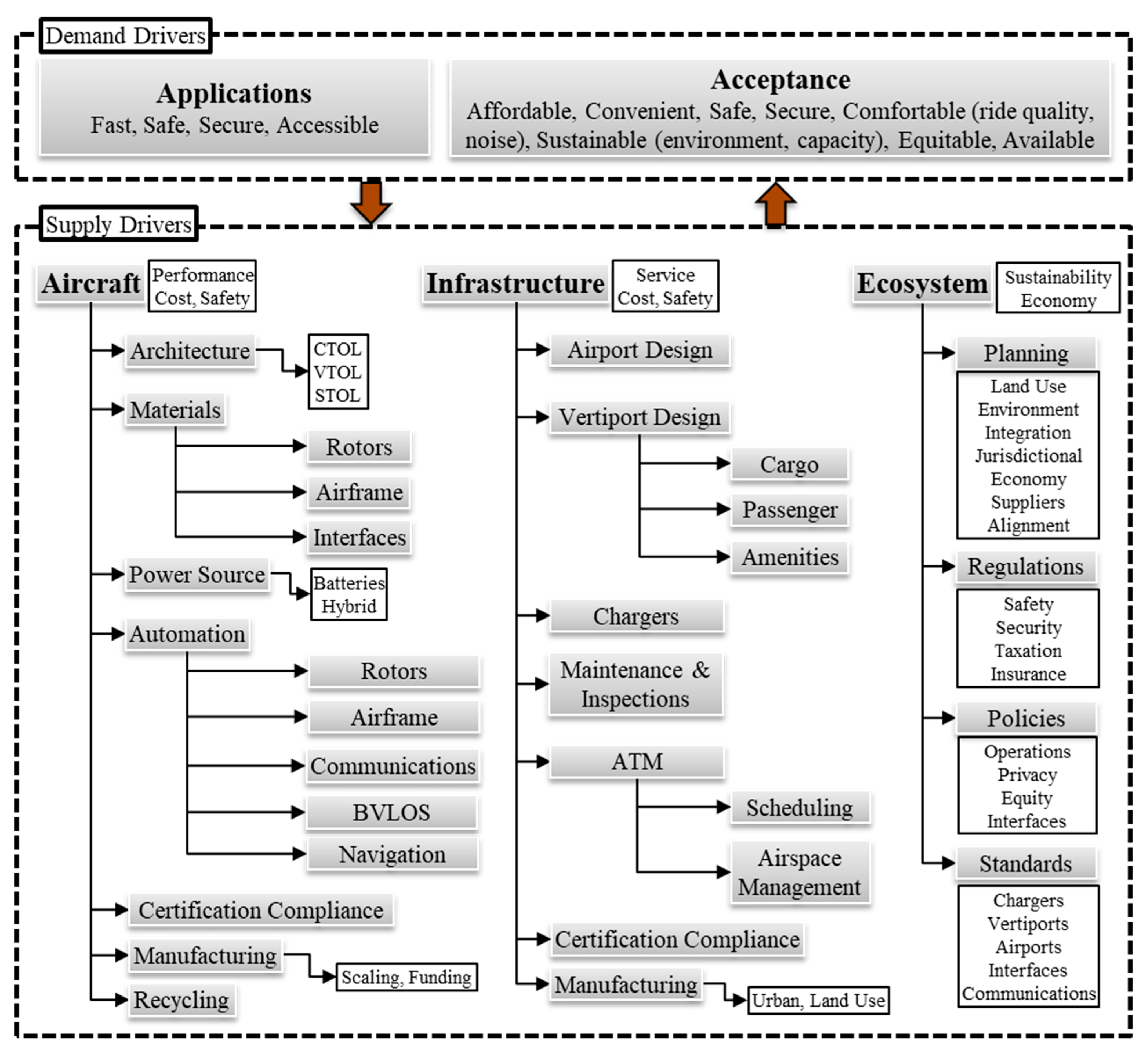
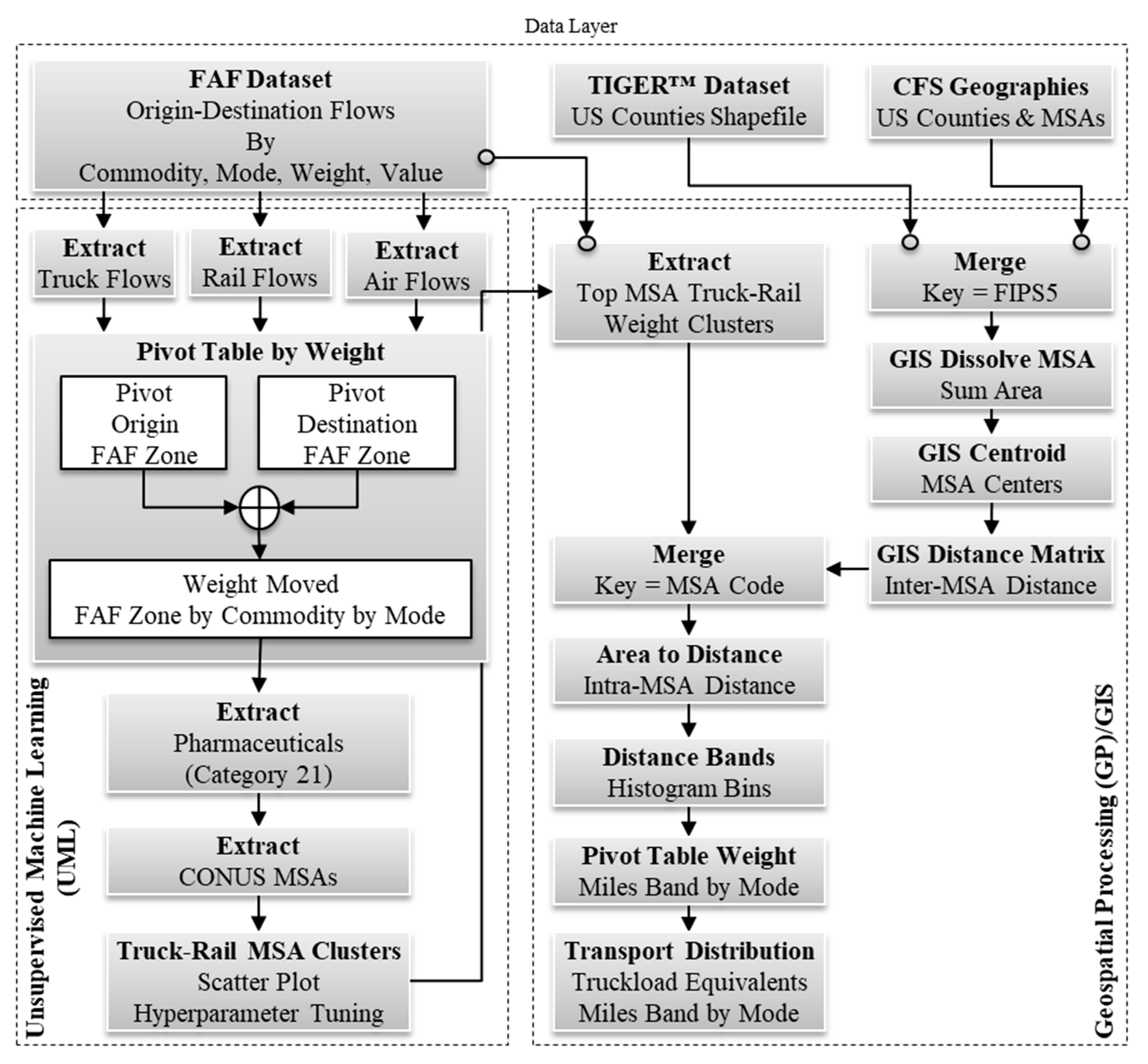
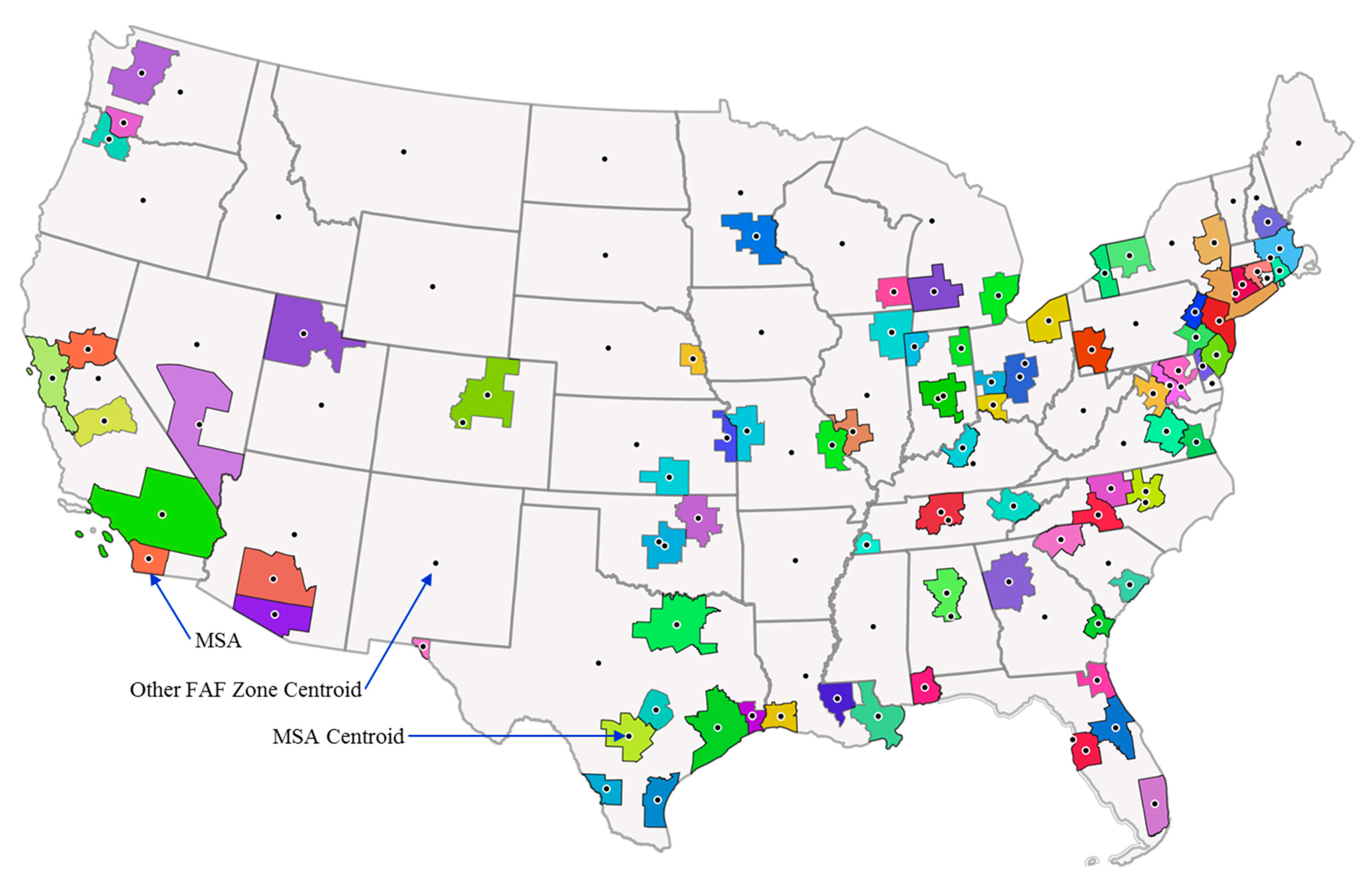

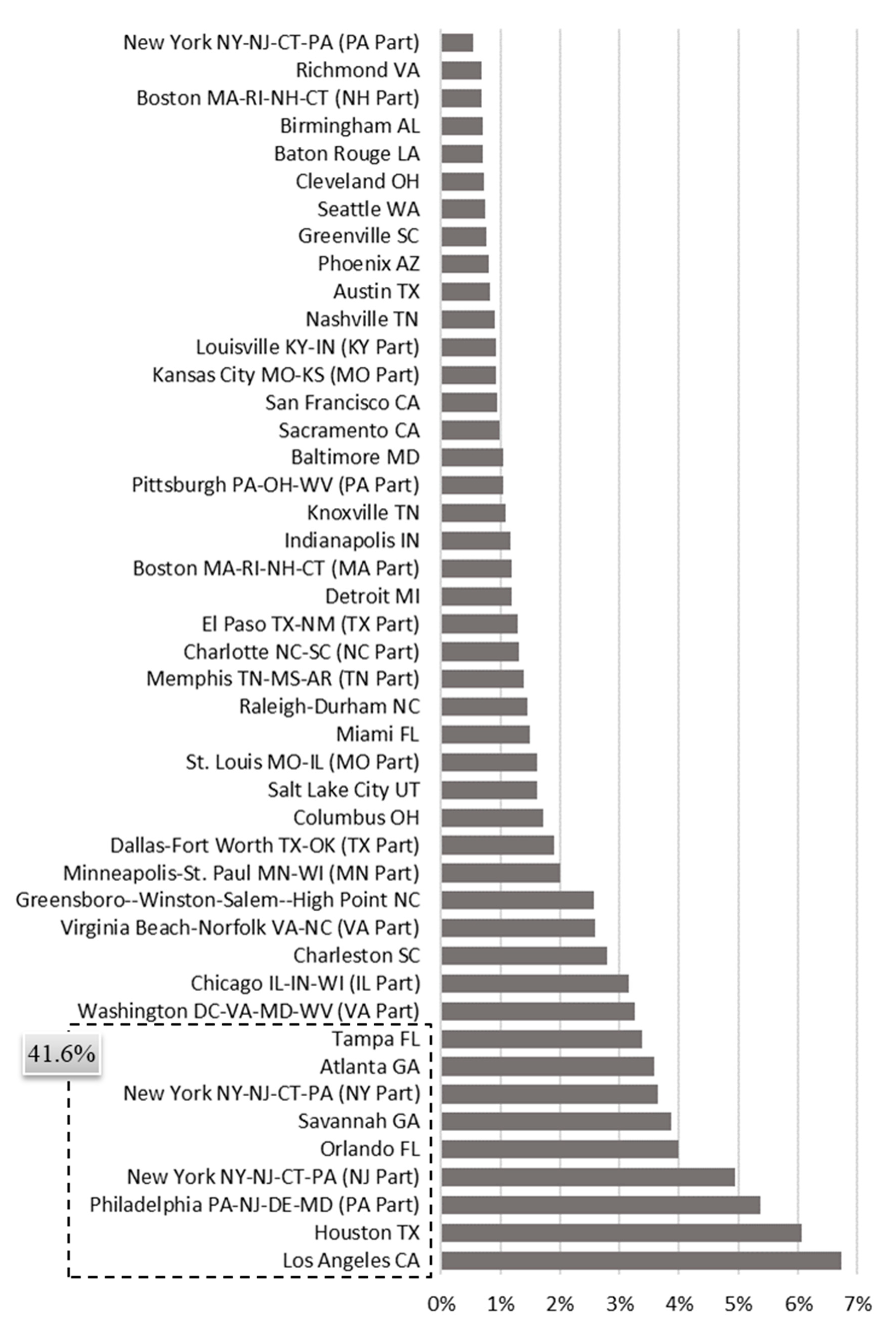
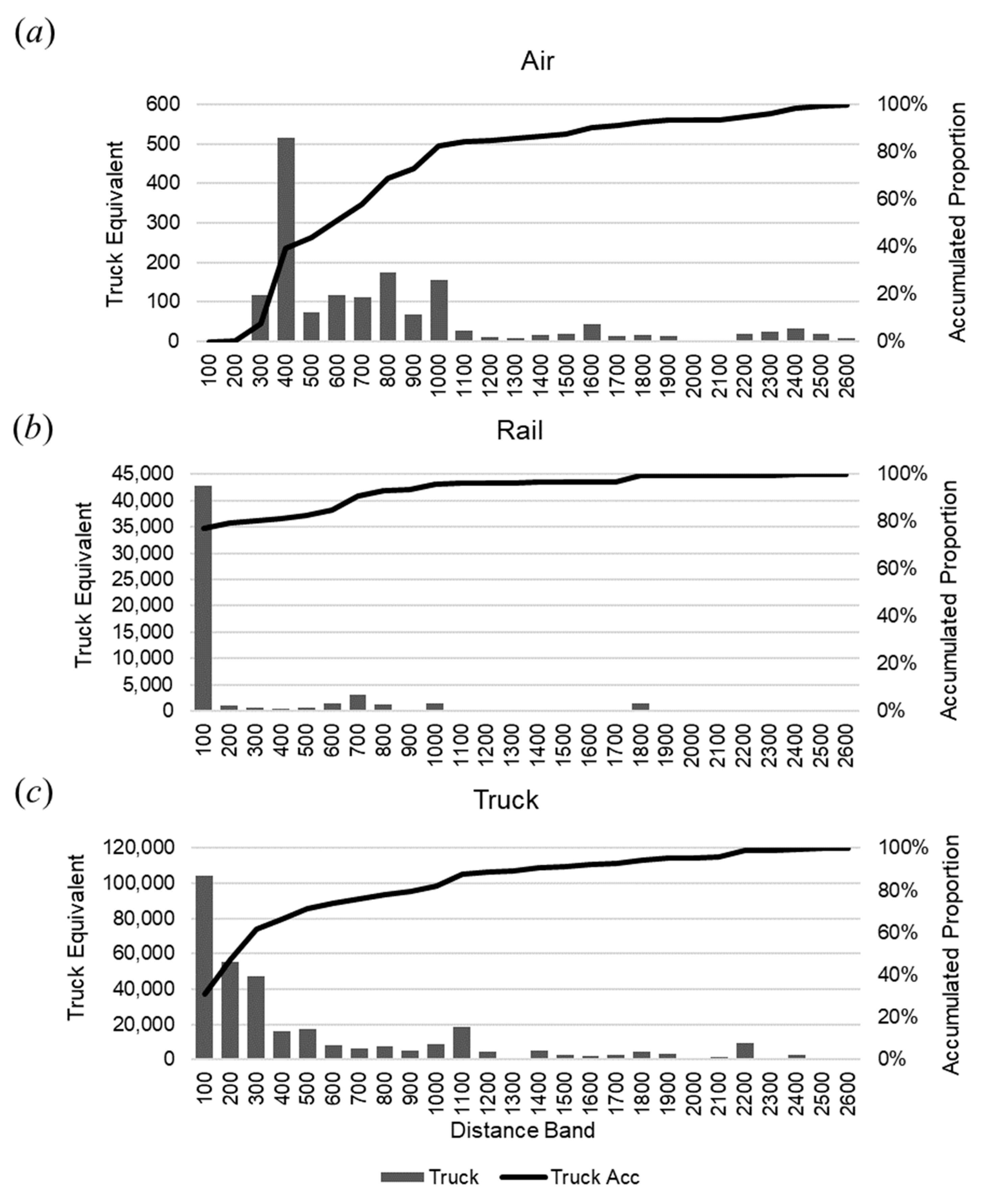
| Algorithm | Theory of Operations | Hyperparameters |
|---|---|---|
| DBSCAN | Density-based spatial clustering of applications with noise (DBSCAN). Separates densely packed points from outliers. Initializes core points as those that are within distance d of k points. Grows a cluster by randomly labeling a core point as a cluster, and then grows that cluster by sequentially adding other core points that are within distance d until it assigns all core points to a cluster. Finally, it assigns non-core points to clusters that are within distance d. It labels the unassigned points as outliers. A: Finds clusters that linear hyperplanes cannot separate. D: Specification of d and k requires heuristics, which can be impractical for large feature spaces. | Normalize features: yes k: 4 d: 0.47 Distance: Euclidean |
| Louvain | Extracts communities from networks by constructing a k-nearest neighbor graph with edges weighted by the number of shared neighbors. The algorithm labeled clusters based on edge density inside communities relative to between communities. A: Algorithms and process large networks quickly. D: The resolution parameter adjusts the cluster size, which can make it difficult to cluster small communities. | Normalize features: no PCA preprocessing: 2 Distance: Euclidean Number of neighbors: 12 Resolution: 5.0 |
| k-means | Randomly selects one point per cluster, and then iteratively recalculates centroids while reassigning points to their nearest centroid. The algorithm converges once cluster reassignments stop, or the number of specified iterations is complete. A: Performs well when clusters are symmetrical. D: Specifying the number of clusters require heuristics. | Normalize features: no Number of clusters: 3 Initialization: k-means ++ Number of reruns: 10 Number of iterations: 300 |
Disclaimer/Publisher’s Note: The statements, opinions and data contained in all publications are solely those of the individual author(s) and contributor(s) and not of MDPI and/or the editor(s). MDPI and/or the editor(s) disclaim responsibility for any injury to people or property resulting from any ideas, methods, instructions or products referred to in the content. |
© 2023 by the author. Licensee MDPI, Basel, Switzerland. This article is an open access article distributed under the terms and conditions of the Creative Commons Attribution (CC BY) license (https://creativecommons.org/licenses/by/4.0/).
Share and Cite
Bridgelall, R. Unlocking Drone Potential in the Pharma Supply Chain: A Hybrid Machine Learning and GIS Approach. Standards 2023, 3, 283-296. https://doi.org/10.3390/standards3030021
Bridgelall R. Unlocking Drone Potential in the Pharma Supply Chain: A Hybrid Machine Learning and GIS Approach. Standards. 2023; 3(3):283-296. https://doi.org/10.3390/standards3030021
Chicago/Turabian StyleBridgelall, Raj. 2023. "Unlocking Drone Potential in the Pharma Supply Chain: A Hybrid Machine Learning and GIS Approach" Standards 3, no. 3: 283-296. https://doi.org/10.3390/standards3030021






